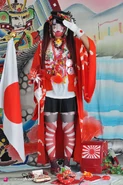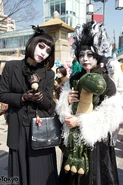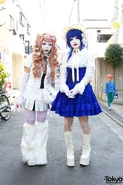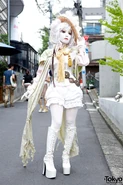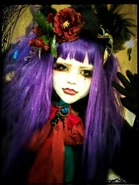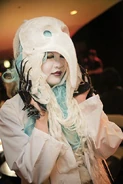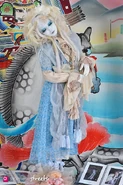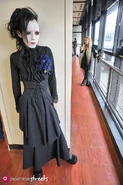Shironuri is a broad Japanese style referring to those who wear heavy white makeup on their faces, and some sort of alternative fashion.
Shironuri was made popular internationally through the work of popular model Minori. [1] The style is a subculture of Visual Kei. [2]
The Name[]
The name Shironuri (白塗り) literally translates to mean "painted in white". Therefore, the name directly describes the key point of the style, the white face paint. [2][3][4][5]
History[]
Shironuri is inspired by the white traditional makeup worn my geisha and traditional Japanese storytellers.
The style originally came about in the 1960s as an expression of right-wing nationalism. Practitioners would paint their faces in the traditional style, and wear school uniforms or military styles, and carry Japanese war flags.
Nowadays the original style of nationalistic shironuri still exists and is worn, but the political association has become less attached to the style. [1]
Style Basics[]
Shironuri as a style is very vague and broad. The only requirement for being shironuri is wearing the white face makeup. However, even that can vary from person to person, with some wearing thick makeup that completely obscures their features, and others wearing lighter makeup, reminiscent of a traditional geisha look. Others will paint their neck and any other visible skin white as well, or wear white gloves and other white accessories to cover exposed skin. However, others only paint their faces and nothing else.
Some who wear shironuri also use false lashes, often in exaggerated styles, such as very long lengths or made of strange materials, such as feathers. Contacts are also popular. Colorful or dark colored hair is most often worn, as it contrasts well with the white face makeup. It is often worn in large, puffy styles as well, again for contrast.
Fashion when it comes to shironuri can be whatever strikes the wearer's fancy, however, it almost always will be some sort of alternative fashion. [3][4][5][6]
Popular trends have existed in the shironuri community since the beginning. In the early 1960s, the common style was school girl and boy style, gakuran and seifuku. Nowadays, the common theme is more goth, visual kei inspired fashion style. Other popular themes are cyberpunk, traditional Japanese or Kimono inspired fashion, and kawaii inspired fashion. Some practitioners also wear another established Japanese fashion, such as Lolita or Decora, but with the addition of the white face makeup. [2]
Brands & Shops[]
As there are no clothing requirements for shironuri, there are no brands attached to the style. Any white stage makeup works for the style as well, so there is no official makeup brand either.
Gallery[]
External Links[]
- ↑ 1.0 1.1 Mary-Ann Russon. "Meet Minori: The Shironuri Fashionista Making Waves on the Streets of Tokyo." International Business Times. May 29, 2014. Retrieved August 26, 2020 from https://www.ibtimes.co.uk/meet-minori-shironuri-fashionista-making-waves-streets-tokyo-1450199
- ↑ 2.0 2.1 2.2 Aline. "Painting your face in white: What is Shironuri?" Tokyo Street Style. February 25, 2018. Retrieved August 26, 2020 from https://www.tss-mag.com/all-white-what-is-shironuri/
- ↑ 3.0 3.1 "SHIRONURI fashion and ANGURA culture." POP kakumei. February 3, 2013. Retrieved August 26, 2020 from http://pop-kakumei.blogspot.com/2013/02/shironuri-fashion-and-angura-culture_3.html
- ↑ 4.0 4.1 "Japanese Shironuri "White Face Monster Party" in Harajuku - Pics & Video." Tokyo Fashion. March 25, 2013. Retrieved August 26, 2020 from http://tokyofashion.com/japanese-shironuri-harajuku-pics-video/
- ↑ 5.0 5.1 "Kawaii-B all about: Shironuri." Kawaii-B. April 23, 2014. Retrieved August 26, 2020 from https://kawaiibuk.blogspot.com/2014/04/kawaii-b-all-about-shironuri.html
- ↑ "Shironuri." Mookychick. September 3, 2014. Retrieved August 26, 2020 from https://www.mookychick.co.uk/indie-fashion/japanese/shironuri.php
For mori information, please see:
- All About Japan - Shironuri Makeup Tutorial
- Japanese Streets - Shironuri

